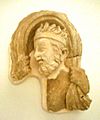Zephyrus facts for kids
Zephyrus is a very important god in Greek mythology. He is known as the god of the West Wind. Zephyrus is often thought of as a gentle and helpful wind. He is married to Iris, who is the goddess of the rainbow. Together, they have a child named Pothus, who represents longing or desire.
Contents
Who is Zephyrus?
Zephyrus is one of the four main wind gods in ancient Greece. These gods are called the Anemoi. Each Anemoi represents a wind from a different direction. Zephyrus brings the soft, warm breezes from the west. These winds are often linked to the arrival of spring and new growth.
The Anemoi: Brothers of the Wind
Zephyrus has three main brothers, who are also wind gods:
- Boreas is the god of the North Wind. He brings cold, strong winds and winter weather.
- Notus is the god of the South Wind. He is known for bringing warm, rainy weather, especially in summer.
- Eurus is the god of the East Wind. He is often linked to bringing dry, hot weather.
These four brothers were believed to live in a palace in Thrace, a region in ancient Greece. They could be calm and helpful, or wild and destructive, depending on their mood.
Zephyrus's Role in Nature
Zephyrus is often seen as a kind and gentle god. His winds help plants grow and flowers bloom. In many ancient stories, he is a messenger of spring. He helps carry seeds and pollen, making the world green and beautiful. Farmers and sailors often welcomed Zephyrus because his winds were mild and predictable.
Zephyrus in Myths and Stories
Zephyrus appears in several famous Greek myths. He is not always the main character, but his actions often help move the story along.
Zephyrus and Flora
In Roman mythology, Zephyrus is often linked with the goddess Flora. Flora is the Roman goddess of flowers and spring. It was believed that Zephyrus's gentle breath helped Flora make flowers bloom. This connection shows how important the West Wind was for nature's beauty.
Zephyrus and Hyacinthus
One sad story involves Zephyrus and a handsome young man named Hyacinthus. Both Zephyrus and the god Apollo admired Hyacinthus. One day, Apollo and Hyacinthus were playing a game with a discus. Zephyrus, feeling jealous, blew the discus off course. It accidentally hit Hyacinthus, causing his death. From Hyacinthus's blood, a beautiful flower, the hyacinth, grew. This myth shows that even gentle gods can sometimes act out of jealousy.
Zephyrus and Psyche
Zephyrus also plays a helpful role in the story of Cupid and Psyche. When Psyche is left on a mountain to be taken by a monster, Zephyrus gently carries her away to a beautiful valley. There, she finds the palace of Cupid, the god of love. Zephyrus acts as a kind helper, moving Psyche safely to her new home.
Zephyrus in Art and Culture
Throughout history, artists have shown Zephyrus in many ways. He is often pictured as a young, handsome man with wings. Sometimes, he is shown blowing air from his mouth.
Ancient Depictions
In ancient Greek and Roman art, Zephyrus often appears on vases, sculptures, and mosaics. The Tower of the Winds in Athens is a famous example. This ancient clock tower has carvings of the eight wind gods, including Zephyrus. These carvings helped people tell the direction of the wind.
Later Art
During the Renaissance and later periods, artists continued to paint Zephyrus. He is often seen with Flora, surrounded by flowers. These artworks highlight his connection to spring and beauty. His gentle nature made him a popular subject for artists wanting to show peace and natural beauty.
Images for kids
-
Wind rose of ancient Greece, created by the scholar Adamantios Korais around 1796
-
Zephyr and Flora, c. 1720, by Antonio Corradini, Victoria and Albert Museum
-
Tower of the Winds in ancient Athens, part of the frieze depicting the Greek wind gods Boreas (north wind, on the left) and Skiron (northwesterly wind, on the right)
-
Greco-Buddhist fragment of the god Boreas with billowing cloak (velificatio) overhead. Hadda, Afghanistan
See also
 In Spanish: Céfiro para niños
In Spanish: Céfiro para niños






